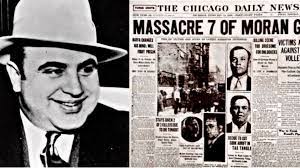The Valentine's Day Massacre
Hello Reversians,
Today is February 15th, nothing special...
But yesterday was Valentine's Day, some will have celebrated love, others freedom... I hope you celebrated with the best combination: freedom in love, because free choice is the only thing I believe leads to true happiness
So today I decided to tell you an unusual story about the day of lovers.
Do you know the story of the "St. Valentine's Day massacre"?
Here it is!
The St. Valentine's Day Massacre, which occurred on February 14, 1929, was one of the bloodiest events in the war between rival gangs during Prohibition. The backstory was that of a struggle for control of territories and profits deriving from alcohol smuggling, which pitted against each other the clans of Al Capone and that of George "Bugs" Moran.
Al Capone, born in 1899 in Brooklyn, New York, became one of the most powerful and influential organized crime bosses during the Prohibition era. Also known as "Scarface" due to a scar on his face, Capone rose to power through alcohol smuggling during prohibition, controlling a vast network of illegal distilleries, nightclubs and illicit businesses.
His influence extended through the city of Chicago and beyond, and Capone was known for his luxurious lifestyle and the ruthless control he exercised over his criminal operations. However, his fame was also marked by acts of violence and murder, which helped cement his reputation as one of the most feared criminals of the era.
On February 14, Capone was in Miami summoned by a federal judge for questioning, a circumstance that would have constituted an alibi for him. Capone's men show up in the garage at 2122 North Clark Street disguised as policemen and, taken by surprise, Moran's men are quickly disarmed and then killed by machine gun fire, with at least fifty shots fired for each. One of them, Frank Gusenberg, was still alive when the police arrived, although he had many bullets in his body; when asked who shot him he replied "nobody shot me" and three hours later he died. For many years Al Capone's alibi holds up, and the accepted theory is that of an execution by corrupt policemen who wanted to silence witnesses who knew too much.
However, public opinion was now convinced of the guilt of Capone and his gang, and the St. Valentine's Day massacre became a symbol of the brutality and violence associated with the world of organized crime during Prohibition.
Only forty years later an old gangster, Alvin Karpis, shed light on the facts.
The victims are Peter Gusenberg, Frank Gusenberg, Adam Heyer, Albert Kachellek, Reinhardt Schwimmer, Albert Weinshank and John May. Bugs Moran was the only survivor, although one victim looked very much like him and was probably killed instead of him. Instead he escaped and, after trying in vain to rebuild the gang, abandoned Chicago forever, later ending up arrested for various bank robberies in the 1930s. He died in prison from lung cancer in 1957. Al Capone thus remained the sole and undisputed master of Chicago.
The actual garage where the massacre occurred was demolished in September 1967, three months after the release of the film The Valentine's Day Massacre; the building area is now occupied by a lawn on the main road and a car park in the back.
Although almost a hundred years have passed since the massacre, the memory of it continues to arouse fascination and interest in the public, fueling the mythology around the figure of Capone and the criminal world of the 1920s.
I like to remember these characters, strong, controversial and brutal, certainly not out of emulation and admiration, but because they have, despite themselves or with conscience, contributed to moving the wheels of history, which sometimes moves out of love, sometimes moves out of interest, sometimes it moves with kindness, and sometimes with violence... but it never stays still.
From the Navigli, that’s all,
shine bright #reversians,
I await you here!
